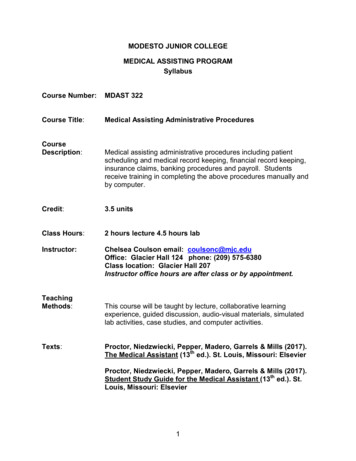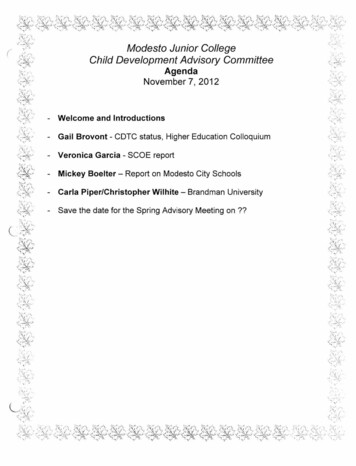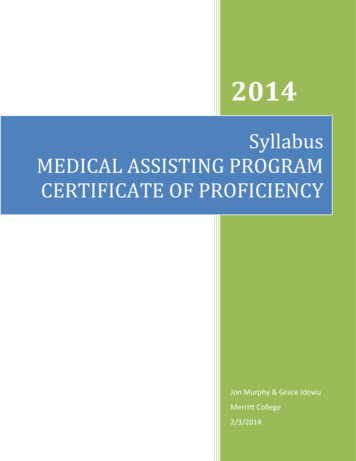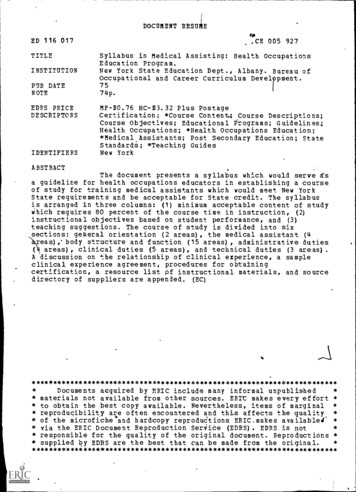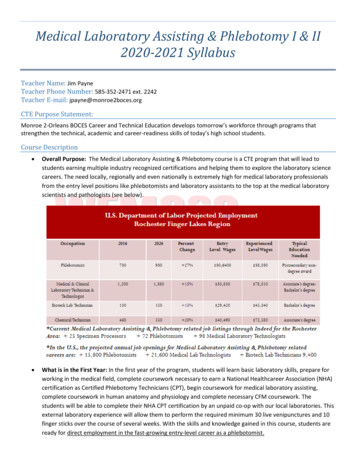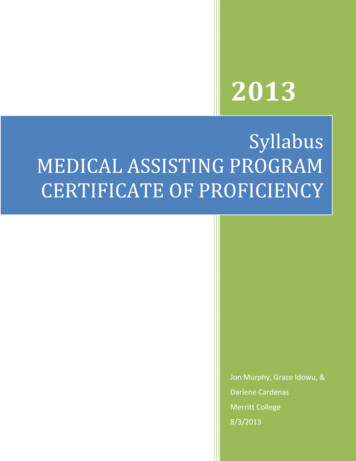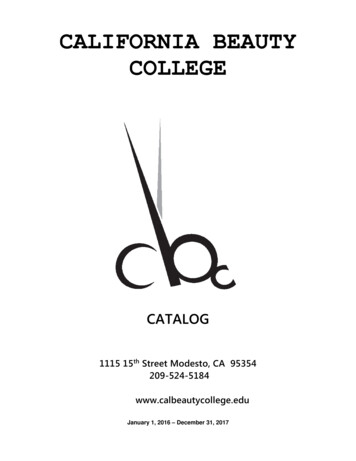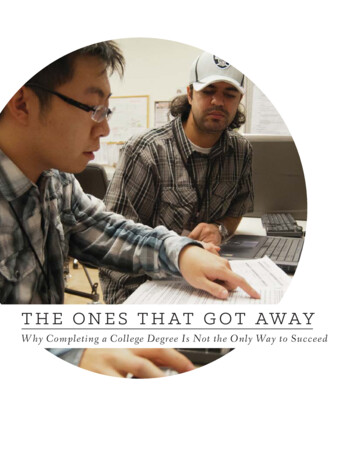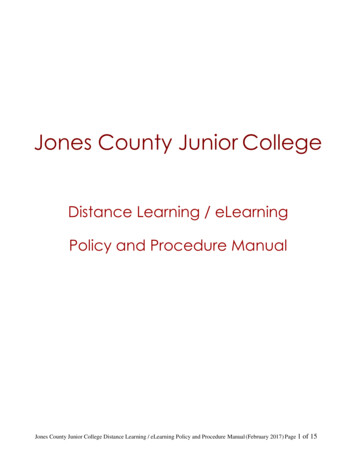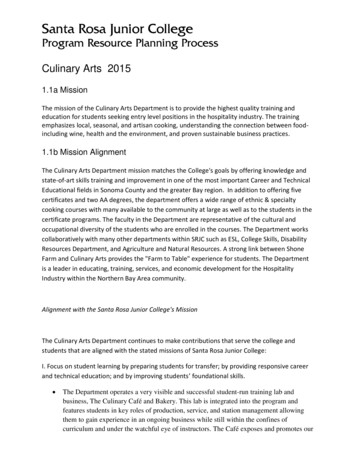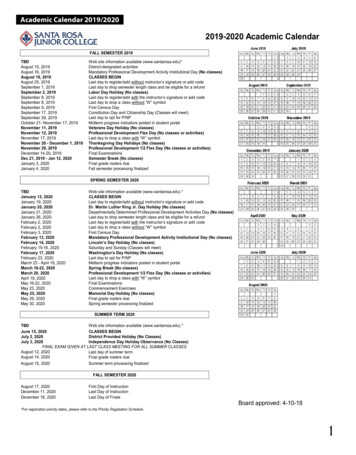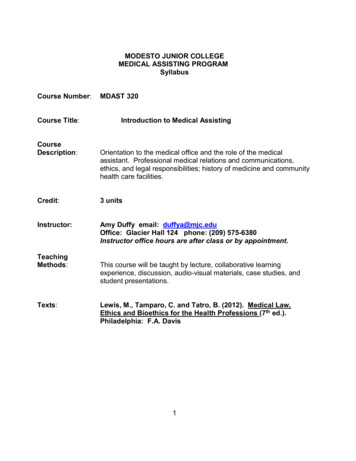
Transcription
MODESTO JUNIOR COLLEGEMEDICAL ASSISTING PROGRAMSyllabusCourse Number:Course Title:CourseDescription:MDAST 320Introduction to Medical AssistingOrientation to the medical office and the role of the medicalassistant. Professional medical relations and communications,ethics, and legal responsibilities; history of medicine and communityhealth care facilities.Credit:3 unitsInstructor:Amy Duffy email: duffya@mjc.eduOffice: Glacier Hall 124 phone: (209) 575-6380Instructor office hours are after class or by appointment.TeachingMethods:Texts:This course will be taught by lecture, collaborative learningexperience, discussion, audio-visual materials, case studies, andstudent presentations.Lewis, M., Tamparo, C. and Tatro, B. (2012). Medical Law,Ethics and Bioethics for the Health Professions (7th ed.).Philadelphia: F.A. Davis1
MinimumPerformanceStandards:The student will receive one grade from this course. Therequirements for satisfactory completion and minimum performancein this course will be evaluated by the instructor based on thestudent's:I.Tests, quizzes, computer assignments and writtenassignments, discussions and case studies.Failure to clearly demonstrate any of the Minimum PerformanceStandards will result in failure of the course.If the student’s performance falls below a “C”, the instructor willrequire a counseling session with the student and complete aStudent Contact Sheet.If improvement does not take place, the instructor will initiateanother meeting with the student and complete a Probation Notice.If the student’s performance remains unsatisfactory, the student willneed to repeat the entire course.Any student required to repeat a medical assisting course will berequired to withdraw from the program and reapply to repeat thecourse the following year.Grading:The grading policy requires a grade of “C” or better to progressin the Medical Assisting Program.A 100-90%B 89-80%C 79-70%D 69-60%F 59% and below2
A. COURSE GOALAs a result of satisfactory completion of this course, the student shouldbe prepared to:Discuss and implement the following topics: law, ethics, bioethics, culturaldifferences and occupational scope of practice as they relate to health care.B. STUDENT LEARNING GOALSMastery of the following learning goals will enable the student to achieve theoverall course goal.Required Learning GoalsUpon satisfactory completion of this course, the student will be able to:a. Define the role of a Medical Assistant and professional organizations.b. Demonstrate professional appearance, grooming, and good health.c. Develop skills necessary to have effective communication with thephysician, coworkers, patients, and the medical community.d. List and describe the different types of medical practices.e. Explain the principles of medical ethics as they relate to the practice ofmedicine.f. Explain the medical assistants and the physician's responsibilities as theyapply to the Medical Practice Acts.g. Identify medical reports that are required by law.h. Explain the functions of health care facilities in the community.3
COURSE LEARNING OUTCOMESUpon satisfactory completion of this course, the student should be prepared to:1.Differentiate between laws, ethics, morals, and protocols; and explain howeach relates to the individual, the medical office, and society as a whole.2.Identify elements of lawsuits, medical malpractice claims, and explain howsuch actions can be prevented or defended.3.Apply privacy laws and confidentiality to all forms of communication in themedical office.4
CHAPTER 1Introduction to Law and EthicsPREPARATION:Read Chapter 1CONTENT:History and importance of law and ethics for the health care practitioner. Keyterminology and how it relates to law, ethics and etiquette. Bioethical issues facing thehealth care practitioner. Consequences of illegal and unethical behavior for the healthcare practitioner.LEARNING OBJECTIVES:1. Define key terms.2. Compare medical law, ethics and bioethics.3. Discuss some bioethical issues in medicine.4. Explain the importance of medical law, ethics, and bioethics in the practice ofmedicine.5. List and discuss at least three ethical codes.6. Describe the American Association of Medical Assistants (AAMA) Code ofEthics.7. Interpret the AAMA Creed.8. Compare/contrast the AAMA and the American Medical Association (AMA)codes of ethics.9. Describe the Patient Bill of Rights.10. Explain the Ethics Check questions.11. Describe characteristics that are important for a professional health careemployee.5
COMPETENCIES:Cognitive Knowledge:X.C4.Xl.C1.Xl.C2.Xl.C3.Summarize Patient Bill of RightsDefine:a.ethicsb.moralsDifferentiate between personal and professional ethicsIdentify the effect of personal morals on professional performancePsychomotor Skills:Xl.P1.Xl.P2.Develop a plan for separation of personal and professional ethicsDemonstrate appropriate response(s) to ethical issuesAffective Behaviors:Xl.A1.Recognize the impact personal ethics and morals have on thedelivery of healthcare6
CHAPTER 2Medical Practice ManagementPREPARATION:Read Chapter 2CONTENT:.Compare various types of medical practices and the advantages and disadvantages toeach. Medical practice management systems. Managed health care plans.LEARNING OBJECTIVES:1. Define key terms.2. Compare and contrast types of medical practice management.3. List two advantages and two disadvantages of each of the types of practicemanagement for both provider and the employee.4. Compare personnel needs in each of the types of practice management.5. Discuss the role of managed care.6. Describe health maintenance organizations (HMOs).7. Discuss joint ventures and preferred provider organizations (PPOs).8. Define the concept of general liability for providers.9. Identify providers’ responsibilities to employees in medical practice.management.COMPETENCIES:Cognitive Knowledge:X.C8.Describe the following types of insurance:a.liability7
CHAPTER 3:The Healthcare Team in the Ambulatory SettingPREPARATION:Read Chapter 3CONTENT:Licensure, certification and requirements for various health care professions; scope ofpractice for ambulatory health care personnel.LEARNING OBJECTIVES:1. Define key terms.2. Discuss licensure, certification and registration of health care professionals.3. Identify the role of the medical assistant (administrative and/or clinical) inambulatory care.4. Provide at least three examples of nonlicensed personnel in the health caresetting.5. List and define the three categories of nurses found in health-care settings andcompare their education and their scope of practice.6. List two similarities and dissimilarities between a physician assistant and a nursepractitioner.7. Describe scope of practice for ambulatory health care personnel.COMPETENCIES:Cognitive Knowledge:X.C1.X.C2.X.C5.Differentiate between scope of practice and standards of care formedical assistantsCompare and contrast provider and medical assistant roles in termsof standard careDiscuss licensure and certification as they apply to healthcareProviders8
CHAPTER 4:State and Federal RegulationsPREPARATION:Read Chapter 4CONTENT:.Medical Practice Acts, licensing requirements for the physician, the role of health carepractitioners concerning privacy, confidentiality, and privileged communication.LEARNING OBJECTIVES:1. Define key terms.2. Identify four common requirements for a physician to be licensed.3. Identify three conditions under which a physician’s license may be revoked.4. Explain the purpose of the DEA and its regulations.5. Identify the five controlled substances drug schedules, giving an example of each.6. Discuss the role of the health professional in preventing and treating substanceabuse.7. Summarize the key points of HIPAA related to health care.8. Explain the key points that should be provided in a clinic’s Notice of PrivacyPractices.9. Explain the main points of the Healthcare Reform Act of 2010.9
COMPETENCIES:Cognitive Knowledge:X.C3.X.C4.Describe components of the Health Insurance Portability &Accountability Act (HIPAA)Summarize the Patient Bill of RightsPsychomotor Skills:X.P1.X.P2.X.P4.Locate a state’s legal scope of practice for medical assistantsApply HIPAA rules in regard to:a.privacyb.release of informationApply the Patient’s Bill Rights as it relates to:a.choice of treatmentb.consent for treatmentAffective Behaviors:X.A1.Demonstrate sensitivity to patient rights10
CHAPTER 5Professional LiabilityPREPARATION:Read Chapter 5CONTENT:Impact of medical malpractice within the health care system. Guidelines for a contract tobe valid, standard of care vs. duty of care, negligence and professional liability, riskmanagement.LEARNING OBJECTIVES:1. Define key terms.2. List three elements necessary for a contract to be valid.3. Describe how a contract may be breached.4. Discuss meaning of standard of care.5. Explain professional liability for providers.6. Identify the four Ds of medical negligence.7. Compare and contrast intentional and unintentional torts.8. Restate, in your own words, the importance of professional liability(malpractice) insurance.9. Name two alternative methods to litigation.10. Recall 10 guidelines for risk management.11
COMPETENCIES:Cognitive practicei.risk managementDescribe the following types of insuranceb.professional (malpractice)Define the following medical legal terms:h.respondent superiori.res ipsa loquitorm.arbitration-mediation12
CHAPTER 6Law for Health ProfessionalsPREPARATION:Read Chapter 6CONTENT:Importance of knowledge of law as it relates to health care professionals, three branchesof government, court systems and the trial process. Entries required for legal protection.LEARNING OBJECTIVES:1. Define key terms.2. Explain in a brief paragraph why knowledge of the law is necessary for healthprofessionals.3. Describe the source of law.4. List the three branches of government in the United States.5. Give an example of each of the following terms (a) constitutional law, (b) commonlaw, (c) statutory law, (d) administrative law, (e) plaintiff, (f) defendant, (g) felony,and (h) misdemeanor.6. List two similarities and two dissimilarities between criminal and civil law.7. Review, in diagram form, the process for a (a) civil case, (b) misdemeanor case,and (c) felony case.8. Diagram the federal court system and state court system.9. List two factors that determine in which court a case is heard.10. Discuss the use of probate and small claims courts.11. List two similarities and two dissimilarities among a subpoena, subpoena ducestecum, and court order.12. Explain, in your own words, the trial process.13. Name two circumstances that might require the services of an expert witness.13
COMPETENCIES:Cognitive Knowledge:X.C6.X.C7.X.C13.Compare criminal and civil law as they apply to the practicingmedical assiatantDefine:c.statute of limitationsDefine the following medical legal terms:g.subpoena duces tecumk.defendant-plaintiffl.deposition14
CHAPTER 7Public DutiesPREPARATION:Read Chapter 7CONTENT:Public duties of physicians and other health care practitioners, the role of medicalexaminer, recording of births and deaths, reporting of communicable diseases, protocolfor vaccine adverse events.LEARNING OBJECTIVES:1. Define key terms.2. List at least five areas of public duties for physicians and providers.3. Discuss importance of completing birth and death certificates.4. Identify three circumstances in which a county coroner or medical examinerwould be called to investigate a death.5. Discuss the importance of prompt reporting of the death of a client.6. Describe process necessary for reporting communicable and notifiablediseases.7.Restate the protocol to use for reporting adverse events of vaccines andtoxoids.8.List four injuries that are reportable.9.Discuss elder and child abuse laws.10. Identify professionals who are required to report suspected child abuse.11. Summarize the five main types of intimate partner violence.12. Describe the process used in gathering and securing evidence in the healthcare setting.13.Discuss Good Samaritan laws.15
COMPETENCIES:Cognitive ify Center for Disease Control (CDC) regulations that impacthealthcare practices settingsDefine:d.Good Samaritan Act(s)Describe the following types of insurance:c.personal injuryDescribe the process in compliance reporting:a.unsafe activitiesb.errors in patient carec.conflicts of interestd.incident reportsDescribe compliance with public health statues:a.communicable diseasesb.abuse, neglect, and exploitationc.wounds of violenceDefine the following medical legal terms:n.Good Samaritan lawsPsychomotor Skills:X.P5.X.P6.X.P7.Perform compliance reporting based on public health statutesReport an illegal activity in the healthcare setting following properprotocolComplete an incident report related to an error in patient careAffective Behavior:III.A1.Recognize the implications for failure to comply with Center forDisease Control (CDC) regulations in healthcare settings16
CHAPTER 8ConsentPREPARATION:Read Chapter 8CONTENT:Implied and informed consent, rights of minors, process of emancipation.LEARNING OBJECTIVES:1. Define key terms.2. Explain legalities of consent.3. Give examples of verbal consent, nonverbal consent and written consent.4. Compare informed and uninformed consent.5. List the four elements of the doctrine of informed consent.6. Identify the following special situations in consent: minors, spouses, anddomestic partners, language barriers, clinical research and when consent isnot necessary.7. Discuss role of the health care employee in the consent process.COMPETENCIES:Cognitive Knowledge:V.C5.V.C8.Recognize the elements of oral communication using senderreceiver processDiscuss applications of electronic technology in effectivecommunication17
X.C13.Define the following medical legal terms:a.informed consentb.implied consentc.expressed consentd.patient incompetencee.emancipated minorf.mature minorPsychomotor Skills:X.P4.Apply the Patient’s Bill of Rights as it relates to:c.refusal of treatment18
CHAPTER 9Medical RecordsPREPARATION:Read Chapter 9CONTENT:Different types of medical records, importance of security and confidentiality,guidelines for retention and release of records, HIPAA.LEARNING OBJECTIVES:1. Define key terms.2. List six purposes of medical records in the ambulatory setting.3. Name and describe two types of charting.4. Describe SOAP/SOAPER and its use in medical records.5. Compare/contrast electronic medical records and electronic health records.6. Demonstrate by example how and when to correct an error in the medicalrecord.7. Discuss the impact of the Healthcare Insurance Portability andAccountability Act (HIPAA) on medical records.8. Describe at least five guidelines f or keeping client informationprivate in electronic medical records and paper medical records.9. Outline the process to follow for when a subpoena or court orderis received for records.10. Explain t h e ownership of medical records.11. Discuss retention and storage of medical records.12. Discuss purging of medical records.19
13. List the required information needed on a release of informationform.COMPETENCIES:Cognitive Knowledge:X.C10.Identify:a.Health Information Technology for Economic and ClinicalHealth (HITECH) ActPsychomotor Skills:X.P3.Document patient care accurately in the medical recordAffective Behavior:X.A2.Protect the integrity of the medical record20
CHAPTER 10Reimbursement and Collection PracticesPREPARATION:Read Chapter 10CONTENT:Importance of appropriate reimbursement and collections and the procedures foreach, laws impacting reimbursement and collections, ethical implications related toreimbursement and collections.LEARNING OBJECTIVES:1.Define key terms.2.Explain, in a short paragraph, the importance ofappropriate reimbursement and collections.3.List at least five guidelines related to reimbursement.4.Recall laws t h a t h a v e a n i m p a c t o n r e i m b u r s e m e n t .5.Describe five government insurance programs.6.Discuss the suggestions that help clients be financially responsible fortheir health care.7.List at least five items to be covered in a collection policy.8.Identify the appropriate procedures to follow when collecting a billby telephone or by mail.9.Identify t h e s e v e n “ c o l l e c t i o n d o n ’ t s ” established by theFederal Trade Commission.10. Discuss solutions to collection problems.11. Explain the one important procedure to follow if a client is deniedcredit because of a poor credit rating.12. List steps to follow in selecting a collection agency.13. Discuss ethical implications regarding reimbursement and collection.21
COMPETENCIES:Cognitive Knowledge:Vlll.C1.Identify:a.types of third party plansb.information required to file a third party claimc.the steps for filing a third party claimPsychomotor Skills:Vlll.P1.Interpret information on an insurance cardAffective Behavior:Vlll.A1.VIII.A2.VIII.A3.Interact professionally with third party representativesDisplay tactful behavior when communicating with medicalproviders regarding third party requirementsShow sensitivity when communicating with patients regardingthird party requirements22
CHAPTER 11Employment PracticesPREPARATION:Read Chapter 11CONTENT:Effective interview process, discrimination as it relates to employment, OSHA,Americans With Disabilities Act, Family Medical Leave Act, techniques forencouraging employee longevity.LEARNING OBJECTIVES:1. Define key terms.2. Discuss the importance of policy manuals.3. Describe the information in personnel policies.4. Explain, in your own words, the importance of correct hiring practices.5. List at least four necessary components of personnel policies.6. Identify the three necessary elements of job descriptions.7. Discuss clinic hours, workweek schedule, benefits, and salaries.8. Explain where and how to locate prospective employees.9.List eight techniques for effective interviews.10. Identify five potential discrimination problems to consider when hiring.11. Describe sexual harassment.12. Explain four parts of the Occupational Safety and Health Act (OSHA).13. Discuss the importance of the Americans With Disabilities Act foremployer and employee.14. Outline the Family Medical Leave Act and its use in the medical practice.23
15. Recall procedures for selecting the right employee.16. Recognize steps that encourage employee longevity.COMPETENCIES:Cognitive Knowledge:X.C9.X.C10.X.C13.List and discuss legal and illegal applicant interview questionsIdentify:c.Americans with Disabilities Act Amendments Act (ADAAA)Define the following medical legal terms:j.locum tenens24
CHAPTER 12A Cultural Perspective for Health ProfessionalsPREPARATION:Read Chapter 12CONTENT:Impact of cultural influence on health care, components of cultural diversity,concept of a new culture in health care, self-evaluation as relates to culturalsensitivity.LEARNING OBJECTIVES:1. Define key terms.2. Discuss the impact of cultural influence on health care.3. Identify the levels of sensitivity to cultural diversity.4.Recall the components of cultural diversity.5. Give an example of each component of cultural diversity.6. Examine the concept of a new culture in health care.7. Evaluate self as related to cultural sensitivity.COMPETENCIES:Cognitive Knowledge:V.C18.Discuss examples of diversity:a.culturalb.socialc.ethnic25
Affective Behavior:V.A3.Demonstrate respect for individual diversity including:a.genderb.racec.religiond.agee.economic statusf.appearance26
CHAPTER 13Allocation of Scarce Medical ResourcesPREPARATION:Read Chapter 13CONTENT:Allocation and access of health care, "defensive" health care; how politics,economics and ethics influence allocation of health care, microallocation andmacroallocation. Key terminology.LEARNING OBJECTIVES:1. Define key terms.2. Compare and contrast
MEDICAL ASSISTING PROGRAM . Syllabus . Course Number: MDAST 320. Course Title: Introduction to Medical Assisting. Course. Description: Orientation to the medical office and the role of the medical assistant. Professional medical relations and communications, ethics, and legal responsibi
